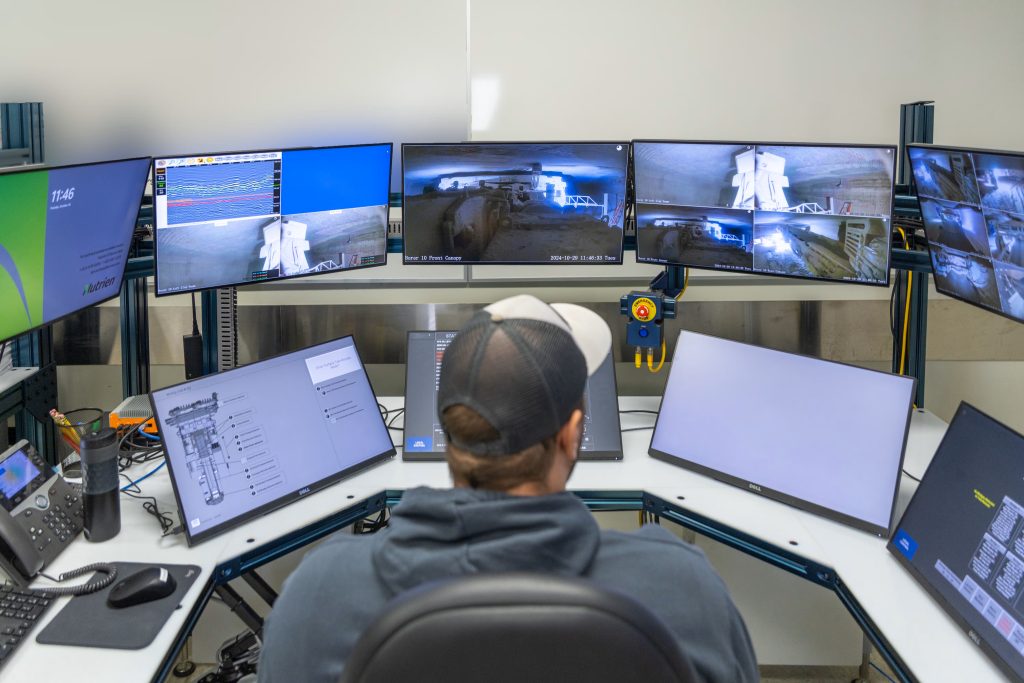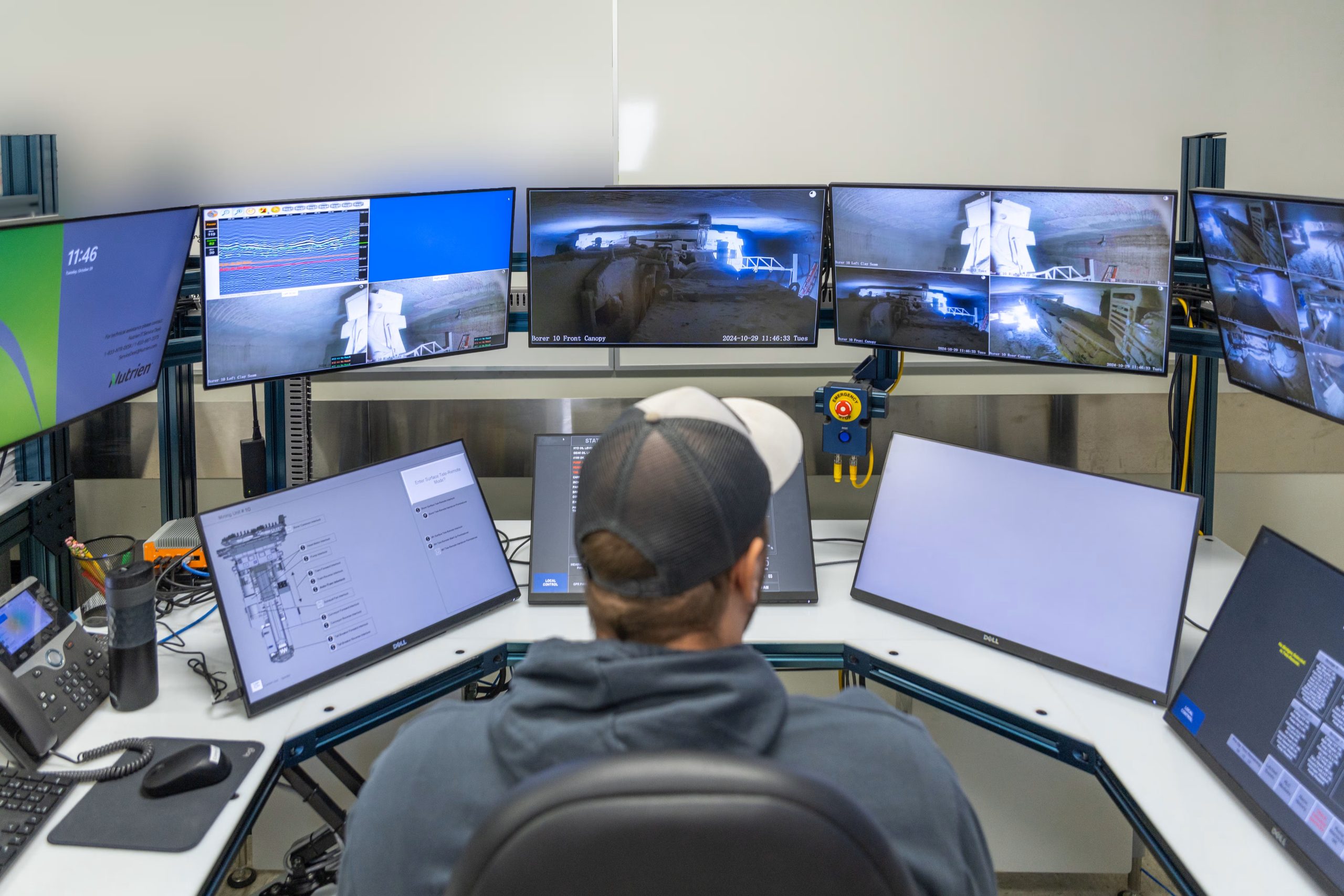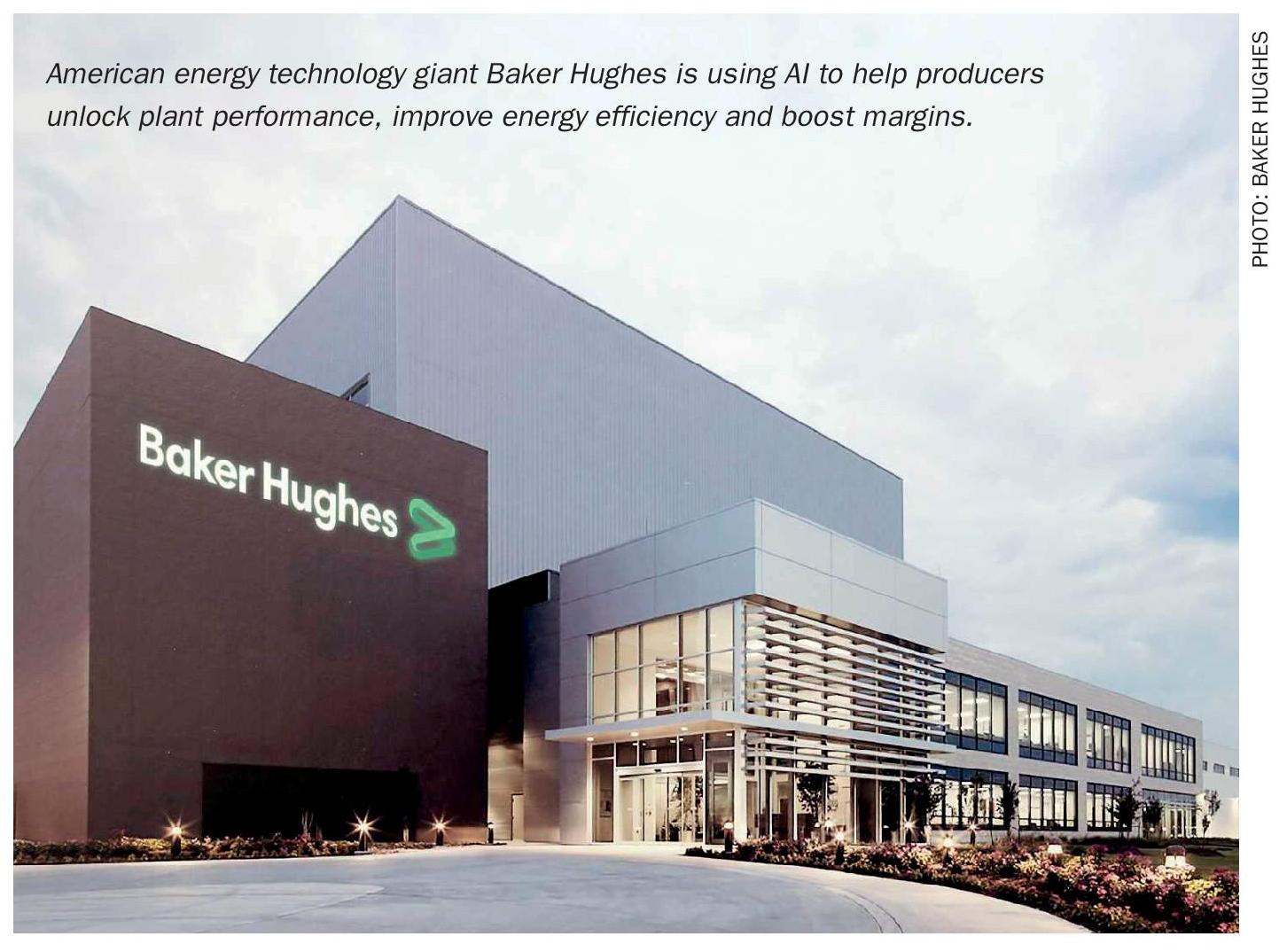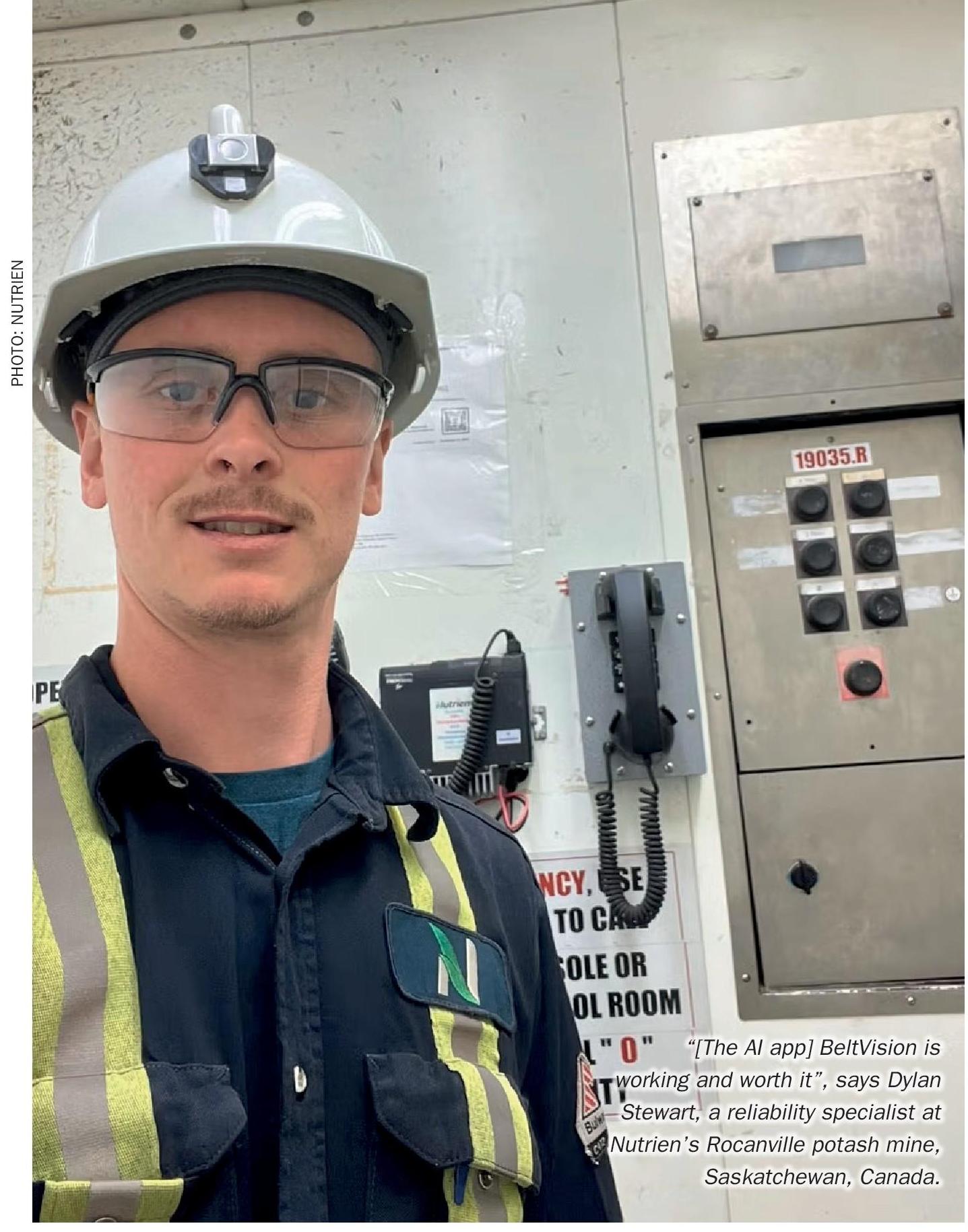Fertilizer International 529 Nov-Dec 2025

21 November 2025
Artificial intelligence – the new normal?
TECHNOLOGY BRIEFING
Artificial intelligence – the new normal?
Businesses are capturing the transformative potential of artificial intelligence (AI) to deliver a step change in productivity. But does AI really herald a revolution in fertilizer production and, if so, what are the practical examples of this?

Automation and artificial intelligence are transforming how Nutrien mines potash and maintains its mining equipment at its production sites in Saskatchewan, Canada. The company is targeting 40-50% automated mine output by the end of 2026.
Protecting food security and the environment
Artificial intelligence (AI) has come a long way in a short time since the launch of ChatGPT in 2022. The AI chatbot is now firmly fixed in the public consciousness, with over 700 million active weekly users currently.
In terms of industry awareness, AI was placed front and centre at the International Fertilizer Association’s 2024 Annual Conference in Singapore (Fertilizer International 521, p34). In the event’s opening keynote, Caroline Yap, Google’s former global managing director for its AI business, explored the technology’s potential to transform the fertilizer business – and help agricultural input providers with their key priorities such as protecting food security and the environment.
“AI is the new normal,” Yap said, adding: “Imagine farmers using this technology to look at and identify what is wrong with their crops and their soils.”
In her view, AI can provide the insights into crop health, crop productivity and water consumption needed as the world shifts to a higher yielding and lower impact food system: a system that is currently under strain due to climate change.
Yap illustrated the benefits of AI via several case studies. These included its use in identifying climate resistant varieties of rice and an AI app used by village farmers in Kenya to diagnose diseases in cassava, maize, potato and wheat.
Overall, AI can maximise the use of geospatial data and combine this with cloud services and data science to deploy agricultural solutions at scale, Yapp concluded.

Impending production revolution?
The presentations programme at IFA’s 2024 conference closed as it began, by returning to the theme of artificial intelligence.
“We’re all at the forefront of a global revolution,” ICL’s head of artificial intelligence Lior Frimet said. “AI is everywhere. It’s also becoming a key function in ICL and our industry. We use AI to extract real value in our businesses. It increases product production efficiency and yield and reduces our inputs,” he said.
“We now have AI models autonomously operating in some areas of our production plants. This is the first big step in this revolution,” Frimet added.
AI is now being used to make real time decisions at ICL’s production plants, with humans transitioning to supervisory roles.
Majda Moumni, the director general of OCP Solutions, stressed that AI is just the latest tool for continual improvement – part of the global digital transformation that manufacturing companies have been undergoing for the last 20 years.
“We need to see it as something that will boost the tools and data that are already available. It will also help build more integrated value chains and enhance mining and industry 5.0 initiatives,” she said.
In mining and production, OCP is using AI for blasting optimisation, energy efficiency, operational performance, predictive maintenance and safety improvements. For small holder farmers, AI can also democratise access to (and the use of) data.
In Morocco, for example, OCP has developed a generative AI app that can provide local farmers with access to information in their native language and dialect.
IFA is clearly taking the artificial intelligence revolution seriously, making it a key theme of both its 2024 and 2025 annual conferences. The Association also launched an AI working group last year with the participation of 30 member companies initially.
Several case studies are provided below as an illustration of how the fertilizer industry is incorporating AI into its production processes.
Transforming predictive maintenance
AI is revolutionising predictive maintenance, according to OCP Maintenance Solutions, by using advanced data analytics and machine learning algorithms to foresee equipment malfunctions before they occur. AI systems can:
• Identify impending failures through real-time data acquisition and sophisticated analysis
• Reduce unexpected downtime and extend machine lifespan by continuously monitoring equipment performance
• Optimise operational schedules and reduce maintenance costs
• Allow for the timely scheduling of repairs and parts replacement.
The company has developed I-Predict®, an advanced AI model for predictive maintenance of critical equipment items. The model can foresee potential failures to ensure uninterrupted industrial operations. Its capabilities include:
• Detecting anomalies in vibration, temperature and oil data
• Anticipating equipment failures using advanced time to failure (TTF) models
• Optimising maintenance schedules through a machine health index (MHI)
• Automating fault classification for bearings, cavitation, misalignment, etc
• Identifying early warning signals to reduce downtime and cut maintenance costs
• Transforming raw sensor data into actionable recommendations with AI decision support.
By detecting anomalies, identifying sensor defects and filtering out bad data, I-Predict® is able to guarantee high quality data for predictive maintenance and accurate diagnostics.
“Our AI doesn’t just monitor. It detects [equipment] faults like bearing wear, misalignment, cavitation, oil turbulence, and electrical issues before they escalate,” says OCP Maintenance Solutions. “By identifying these problems early, I-Predict® helps prevent costly downtime, optimises maintenance, and keeps operations running at peak performance.”
By incorporating AI, the technology offers the following specific benefits, in comparison to standard approaches to equipment maintenance:
Automated fault detection. With advanced algorithms and AI models, I-Predict® automatically identifies and diagnoses errors without the need for manual intervention. To hunt the root cause, data gathered from global vibrator monitoring is used to diagnose and measure the severity of underlying critical issues – such as misalignment, bearing wear and gear defects.
Early fault detection (EFD). This enables the identification of probable equipment failures through the analysis of the main warning signals – such as unusual vibration, out of the ordinary temperatures and wear patterns – for quick maintenance and rapid intervention to reduce the risk of costly downtime.
Machine health index (MHI). The MHI takes complex data from sensors and turns it into a simple, intuitive score ranging from 0-100, making it easy to track the condition of equipment at a glance. Powered by AI, it constantly monitors vibration patterns and key performance indicators, helping to catch early signs of wear and mechanical stress. MHI captures both real-time monitoring and historical data trends to provide a reliable assessment of an asset’s condition.
Time to failure (TTF). Knowing when a component is likely to fail is just as important as knowing its current condition. TTF uses AI to predict the time of the next potential failure under real operating conditions, an insight that allows operators to plan ahead with accuracy. Instead of scrambling to deal with unexpected breakdowns, operators can proactively schedule maintenance at a suitable time.
Action advisor. This ‘smart’ tool offers real-time recommendations on maintenance tasks. Based on predictive analytics, it provides straightforward advice on when to replace components or make operational tweaks.
Deploying AI in predictive maintenance does, however, requires a clear strategy, says OCP Maintenance Solutions:
“Companies need to integrate predictive models with their computerised maintenance management system (CMMS), ensure high-quality sensor data, and train maintenance teams to adopt new workflows. By combining condition-based maintenance with our advanced AI model, organisations can align operations, improve reliability, and maximise return on investment,” it advises.
New era for fertilizer production?
Baker Hughes is using AI and machine learning (ML) to help producers unlock plant performance, improve energy efficiency, and boost margins. The company’s AI solution – Cordant™ Process Optimization – is aiming to allow energy and chemical producers to thrive in a tightening market.

As the fertilizer industry embraces digital technologies, AI-driven real-time optimisation (RTO) is emerging as a key approach to generating the best value from existing assets, suggests Baker Hughes1 .
Digital adaptation has been underway for decades with tools such as advanced process control (APC) and model predictive control (MPC) now widely used. Yet, says Baker Hughes, these often fall short when it comes to delivering plant-wide optimisation.
This is where AI-driven optimisation could change the game, in its view. Ammonia plants, for example, can close the gap between current performance and true potential by continuously analysing live data and adjusting key process levers – such as reformer outlet temperature, steam-to-carbon ratio and compressor suction pressure. The end result is increased throughput, reduced energy consumption, and improved operating margins.
In a recent case study, AI-powered Cordant™ Process Optimization was implemented by a major ammonia producer in the Middle East to address production losses caused by dynamic operating conditions. The outcome was a 1.2–1.8% increase in daily production – this being achieved over and above what APC systems had already delivered.
These kinds of improvement translate into significant value, says Baker Hughes, especially in high-cost or resource-intensive operating environments.
“Calling it a new era for fertilizer production might be a stretch, but the challenges facing the fertilizer industry aren’t going away. But with the right tools, producers can turn complexity into opportunity. By embracing AI-powered process optimization, they can unlock hidden value in their existing assets – without the need for costly upgrades or overhauls. This isn’t just about automation. It’s about building a smarter, more resilient, and more sustainable future for fertilizer production,” says Jesper Poulsen, Senior Sales Manager, Cordant Solutions – Process Optimization.
AI-powered process modelling is fundamental to how Cordant™ Process Optimization works.
Unlike traditional models, which often oversimplify complex plant behaviour, this system uses customised non-linear models based on pre-designed templates tailored for industrial processes. This means they can capture the true dynamics of a plant – in terms of how variables interact, how conditions shift, and how performance changes over time.
Development, training and deployment is remarkably fast too. While traditional model implementation can take a year or more, Baker Hughes’ AI-enabled Cordant™ system can be up and running in just 3–4 months.
Working independently of the existing APC system, AI can also unlock additional efficiency gains without disrupting current operations. This was the case for the Middle Eastern ammonia producer mentioned above, who achieved results above and beyond what APC alone could offer.
So, what does AI mean for plant operators?
“It means they’re no longer just reacting to or chasing setpoints. They’re making informed decisions, guided by predictive insights and real-time simulations. They can run ‘what-if’ scenarios, visualize performance gaps, and steer the plant toward optimal conditions – all through an intuitive interface designed for real-world use,” concludes Baker Hughes.
“In short, AI-driven real-time optimization doesn’t just improve numbers – it elevates the role of the operator, turning them into strategic decision-makers at the heart of a smarter, more resilient plant,” the company adds.
Deploying AI at potash mines
Nutrien is putting AI into practice at its potash mining operations in Saskatchewan, Canada, deploying the technology for the predictive maintenance of ore handling equipment such as conveyors2.

BeltVision was first introduced at Nutrien’s Rocanville site in 2020, after the company identified the mainline conveyor belts as a significant bottleneck and source of downtime. These belts, which stretch over many kilometres, transport the ore from boring machines to the hoists that bring it to the surface – essentially operating as the mine’s arteries.
Splice failures, however, are a major recurring maintenance issue with these belts. Mechanical splices, a series of zipper-like clips, are used connect two pieces of belt together – and, unfortunately, sometimes they fail.
BeltVision uses AI to recognise and analyse belt splices and damage.
“We can see detailed images of splice clips while the belt conveys ore. We also have employees doing a physical visual inspection of the belt and documenting how many damaged splices they observed. We use BeltVision to help determine when we should schedule a repair,” says Dylan Stewart, a reliability specialist at Rocanville, speaking last year.
“The cameras operate in hot, dusty environments. They see a lot of vibration. We must stay on top of keeping the camera lens’ clean, and ensuring the proper hardware is installed to keep the camera protected,” Stewart added.
Prior to BeltVision being installed, production at Rocanville was regularly halted due to scheduled shutdowns. Expensive manual splice inspections needed to be carried out, resulting in downtime.
In an early morning shift in May last year, Stewart experienced firsthand why BeltVision is being talked of as a game changer for the mining industry. While using the AI app that morning, he noticed that a conveyor belt splice had incurred significant damage.
“Under normal conditions, if a splice was noticed in the middle of the night, a decision would be made on whether it is going to last until the belt crew arrives. A reliability team member happened to be viewing the active belts that the miners were dumping ore onto that night and, as this was happening, the damaged splice was noticed.
“The damage was significant enough that operations had to be notified immediately to avoid a failure. The crew captain made the decision to stop the belt and allow our employees to make the repair,” he explained.
That single incident improved awareness of BeltVision’s predictive maintenance abilities.
“This opened a lot of positive conversations around proactive maintenance, BeltVision technology, and using operations to repair belts. There were some production employees who were unaware of our ability to monitor splice conditions. Without having the ability to view the splices in detail, we stood a greater chance of having a failure on a splice,” Stewart concluded.
References





